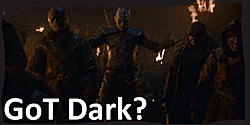


Issues Management in the Dark: Game of Thrones Messes Up, Won’t Fess Up
[by Howard Fencl, Hennes Communications] Our blog posts typically deal with heavy-going crisis fare. I’m lightening up just this once because of an audacious filmmaker’s response to a Sunday evening tsunami of social media angst washing over the third episode in this, the final season of Game of Thrones.
Did you see it?
Probably not. No one did, even if you were watching it. Why? The episode, depicting the much-ballyhooed battle between living scimitar wielding characters and a legion of CGI-enhanced zombies intent on obliterating mankind was dark. Too dark. So dark, in fact, that the multimillion dollar effects flew by in a wasted blur of black and gray. Fans revolted, their anger trending on Twitter.
I watch Game of Thrones (GoT) – and admit to doing so – because my wife is a huge fan. I admit that I started watching with her as one of those things husbands do to keep the peace. I even surprised her with official GoT cabernet glasses for Christmas, from which we imbibe ONLY when watching a new episode (or, as we have done over the past weeks, re-watching all previous seven seasons to “prep” for this season’s final melee). Whether it is Stockholm syndrome or spellbinding storytelling, I have somehow become a hapless Thronie, counting down until HBO flips the switch on Sunday evenings and lets loose a new episode.
After countless promos hyping the third episode, “The Long Night,” I approached Sunday night with apprehension (would my favorite characters survive this battle to end all battles?) and anticipation (would my favorite characters survive this battle to end all battles?). What I witnessed, sipping a dry red in my GoT goblet, was mostly blackness, occasionally lit by CGI dragon fire and flaming swords.
We turned off all the lights. We adjusted the black level on our flat screen. We squinted and squinted harder. Black. I checked Twitter. An avalanche of angst.
So how did the show’s cinematographer respond to the hue and cry? Did he fess up that the episode was just too dark? Did he apologize? No.
He blamed viewers.
“A lot of the problem is that a lot of people don’t know how to tune their TVs properly,” cinematographer Fabian Wagner told Wired UK. “A lot of people also unfortunately watch it on small iPads, which in no way can do justice to a show like that anyway.”
Not only were viewers apparently too dim to use their TV’s brightness controls, Mr. Wagner feels they really didn’t need to see anything anyway: “Personally I don’t have to always see what’s going on because it’s more about the emotional impact.”
Mr. Wagner went on to suggest that HBO’s compression algorithm added to the murkiness. And for good measure, he also blamed the show’s head honchos: “The showrunners decided that this had to be a dark episode.”
If you’re the cinematographer of one of the most successful television series ever made, aren’t you supposed to serve the audience who made the show a success whether they’re watching on a flat screen, an iPad or a mobile phone?
In crisis and issues management, our mantra is always: IF YOU MESS UP, FESS UP.
While the issue here is ephemeral in the grand scheme of things, the outpouring of complaints deserved an admission that this Game of Thrones episode should have been more viewable, an apology that it wasn’t, and a promise that the final three episodes would lighten up. Instead we got Game of Blame, leaving viewers puzzling in the dark.
###